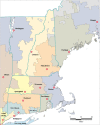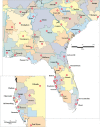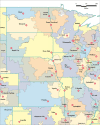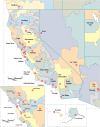Except where otherwise noted, this work is licensed under a Creative Commons Attribution-NonCommercial-NoDerivatives 4.0 International License. To view a copy of this license, visit https://creativecommons.org/licenses/by-nc-nd/4.0/
NCBI Bookshelf. A service of the National Library of Medicine, National Institutes of Health.
Cronenwett JL, Birkmeyer JD. The Dartmouth Atlas of Vascular Health Care: The Center for the Evaluative Clinical Sciences and The Center for Outcomes Research and Evaluation [Internet]. Chicago (IL): American Hospital Publishing, Inc.; 2000 Oct.

The Dartmouth Atlas of Vascular Health Care: The Center for the Evaluative Clinical Sciences and The Center for Outcomes Research and Evaluation [Internet].
Show detailsThe use of health care resources in the United States is highly localized. Most Americans use the services of physicians whose practices are nearby. Physicians, in turn, are usually affiliated with hospitals that are near their practices. As a result, when patients are admitted to hospitals, the admission generally takes place within a relatively short distance of where the patient lives. This is true across the United States. Although the distances from homes to hospitals vary with geography—people who live in rural areas travel farther than those who live in cities—in general most patients are admitted to a hospital close to where they live which provides an appropriate level of care.
The Medicare program maintains exhaustive records of hospitalizations, which makes it possible to define the patterns of use of hospital care. When Medicare enrollees are admitted to hospitals, the program’s records identify both the patients’ places of residence (by ZIP code) and the hospitals where the admissions took place (by unique numerical identifiers). These files provide a reliable basis for determining the geographic pattern of health care use, because research shows that the migration patterns of patients in the Medicare program are similar to those for younger patients.
Medicare records of hospitalizations were used to define 3,436 geographically distinct hospital service areas in the United States. In each hospital service area, most of the care received by Medicare patients is provided in hospitals within the area. Based on the patterns of care for major cardiovascular surgery and neurosurgery, hospital service areas were aggregated into 306 hospital referral regions; this Atlas reports on patterns of care in these hospital referral regions.
How Hospital Service Areas Were Defined
Hospital service areas were defined through a three-step process. First, all acute care hospitals in the 50 states and the District of Columbia were identified from the American Hospital Association and Medicare provider files and assigned to the town or city in which they were located. The name of the town or city was used as the name of the hospital service area, even though the area might have extended well beyond the political boundary of the town. For example, the Mt. Ascutney Hospital is in Windsor, Vermont. The area is called the Windsor hospital service area, even though the area serves several other communities.
In the second step, all 1992 and 1993 Medicare hospitalization records for each hospital were analyzed to ascertain the ZIP code of each of its patients. When a town or city had more than one hospital, the counts were added together. Using a plurality rule, each ZIP code was assigned on a provisional basis to the town containing the hospitals most often used by local residents.
The analysis of the patterns of use of care by Medicare patients led to the provisional assignment of five post office ZIP codes to the Windsor hospital service area.
The third step involved the visual examination of the ZIP codes using a computer-generated map to make sure that the ZIP codes included in the hospital service areas were contiguous. In the case of the Windsor area, inspection of the map led to the reassignment of Pomfret to the Lebanon hospital service area. In the final determination, the Windsor hospital service area contained four communities and a total population of 8,165.
Details about the method of constructing hospital service areas are given in the Appendix on Methods.
Hospital Service Areas in the United States
The documentation of the patterns of use of hospitals according to Medicare enrollee ZIP codes during 1992-93 led to the aggregation of approximately 42,000 ZIP codes into 3,436 hospital service areas. In each area, more Medicare patients were hospitalized locally than in any other single hospital service area. The propensity of patients to use local hospitals is measured by the localization index, which is the percentage of all residents’ hospitalizations that occur in local hospitals (the number of local hospitalizations of residents divided by all hospitalizations of residents). This index varied from a low of 17.9% to over 94%. More than 85% of Americans lived in hospital service areas where the majority of Medicare hospitalizations occurred locally. More than 51% lived in areas where the localization index exceeded 70%.

Figure A3.
Cumulative Percentage of Population of the United States According to the Hospital Service Area Localization Index (1992-93). The localization index is the proportion of all hospitalizations for area residents that occur in a hospital or hospitals within (more...)
In 1993, most Americans lived in hospital service areas with three or fewer local hospitals. Eighty-two percent, or 2,830, of all hospital service areas, which comprised 39% of the population in 1990, had only one hospital. Four hundred twenty-eight hospital service areas, which comprised 23% of the United States population, had either two or three hospitals. One hundred seventy-eight, or less than 6% of hospital service areas, had four or more local hospitals and comprised about 37% of the population of the United States.
How Hospital Referral Regions Were Defined
Hospital service areas make clear the patterns of use of local hospitals. A significant proportion of care, however, is provided by referral hospitals that serve a larger region. Hospital referral regions were defined in this Atlas by documenting where patients were referred for major cardiovascular surgical procedures and for neurosurgery. Each hospital service area was examined to determine where most of its residents went for these services. The result was the aggregation of the 3,436 hospital service areas into 306 hospital referral regions. Each hospital referral region had at least one city where both major cardiovascular surgical procedures and neurosurgery were performed. Maps were used to make sure that the small number of “orphan” hospital service areas—those surrounded by hospital service areas allocated to a different hospital referral region—were reassigned, in almost all cases, to ensure geographic contiguity. Hospital referral regions were pooled with neighbors if their populations were less than 120,000 or if less than 65% of their residents’ hospitalizations occurred within the region.
Hospital referral regions were named for the hospital service area containing the referral hospital or hospitals most often used by residents of the region. The regions sometimes cross state boundaries. The Evansville, Indiana, hospital referral region (Map C) provides an example of a region that is located in three states: Illinois, Indiana, and Kentucky. In this region, three hospitals provided cardiovascular surgery services. Two were in Evansville; a third hospital, in Vincennes, Indiana, also provided cardiovascular surgery, but in the years of this study residents of the Vincennes area used cardiovascular and neurosurgery procedures provided in Evansville more frequently than those in Vincennes, resulting in the assignment of the Vincennes hospital service area to the Evansville hospital referral region.
Map C also provides an example of a region with a population too small to meet the minimum criterion for designation as a hospital referral region. The Madisonville, Kentucky, hospital service area met the criterion as a hospital referral region on the basis of the plurality rule, but its population was less than 57,000. The area was assigned to the Paducah, Kentucky, hospital referral region because hospitals in Paducah were the second most commonly used place of care for cardiovascular and neurosurgical procedures.
Maps of Hospital Referral Regions in the United States
The maps on the following pages outline the boundaries of the hospital referral regions. Although in some regions more than one city provided referral care, each hospital referral region was named for the city where most patients receiving major cardiovascular surgical procedures and neurosurgery were referred for care.

Map D.
New England Hospital Referral Regions.

Map E.
Northeast Hospital Referral Regions.

Map F.
South Atlantic Hospital Referral Regions.

Map G.
Southeast Hospital Referral Regions.

Map H.
South Central Hospital Referral Regions.

Map I.
Southwest Hospital Referral Regions.

Map J.
Great Lakes Hospital Referral Regions.

Map K.
Upper Midwest Hospital Referral Regions.

Map L.
Rocky Mountains Hospital Referral Regions.

Map M.
Pacific Northwest Hospital Referral Regions.

Map N.
Pacific Coast Hospital Referral Regions.
Footnotes
- *
Abstracted from the 1996 edition of the Dartmouth Atlas of Health Care
- Appendix on the Geography of Health Care in the United States - The Dartmouth At...Appendix on the Geography of Health Care in the United States - The Dartmouth Atlas of Vascular Health Care
Your browsing activity is empty.
Activity recording is turned off.
See more...


